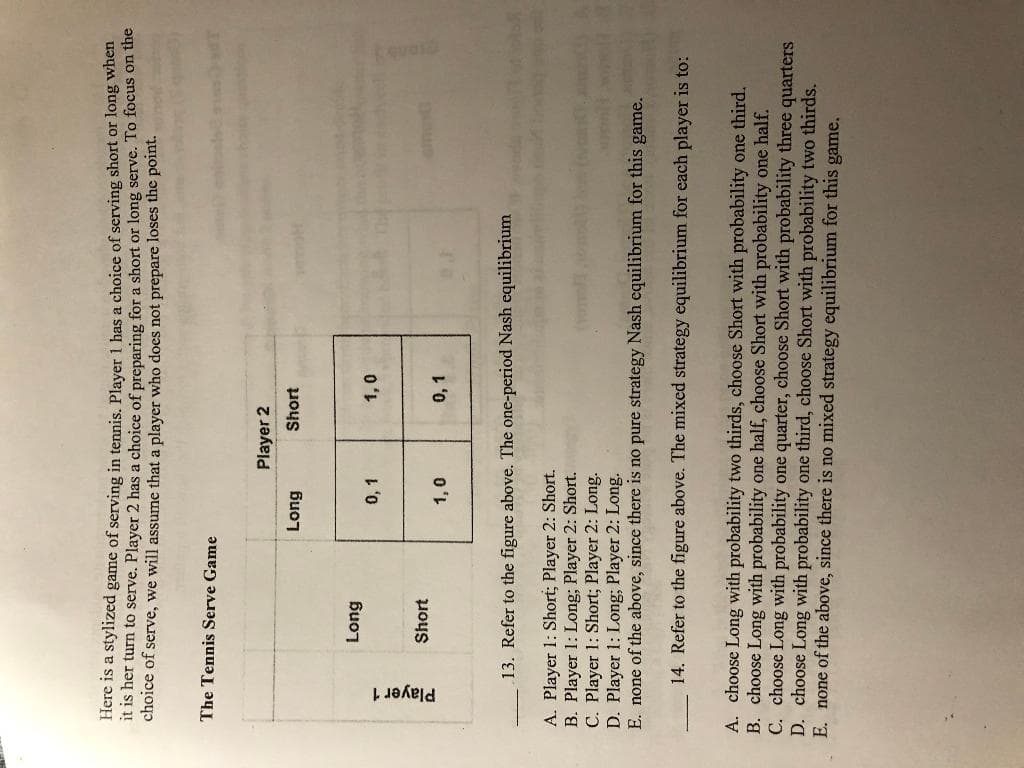rve Game g art Long 0,1 1,0 Player 2 Short 1,0 0,1 to the figure above. The one-period Nash equil ort; Player 2: Short. ng; Player 2: Short. ort; Player 2: Long. mg; Player 2: Long. bove, since there is no pure strategy Nash equi to the figure above. The mixed strategy equili
rve Game g art Long 0,1 1,0 Player 2 Short 1,0 0,1 to the figure above. The one-period Nash equil ort; Player 2: Short. ng; Player 2: Short. ort; Player 2: Long. mg; Player 2: Long. bove, since there is no pure strategy Nash equi to the figure above. The mixed strategy equili
Chapter8: Game Theory
Section: Chapter Questions
Problem 8.7P
Related questions
Question
.

Transcribed Image Text:Player 1
Here is a stylized game of serving in tennis. Player 1 has a choice of serving short or long when
it is her turn to serve. Player 2 has a choice of preparing for a short or long serve. To focus on the
choice of serve, we will assume that a player who does not prepare loses the point.
The Tennis Serve Game
Player 2
Short
Long
0,1
Short
0,1
13. Refer to the figure above. The one-period Nash equilibrium
A. Player 1: Short; Player 2: Short.
B. Player 1: Long; Player 2: Short.
C. Player 1: Short; Player 2: Long.
D. Player 1: Long; Player 2: Long.
E. none of the above, since there is no pure strategy Nash equilibrium for this game.
14. Refer to the figure above. The mixed strategy equilibrium for each player is to:
A. choose Long with probability two thirds, choose Short with probability one third.
B. choose Long with probability one half, choose Short with probability one half.
C. choose Long with probability one quarter, choose Short with probability three quarters
D. choose Long with probability one third, choose Short with probability two thirds.
E. none of the above, since there is no mixed strategy equilibrium for this game.
Expert Solution
This question has been solved!
Explore an expertly crafted, step-by-step solution for a thorough understanding of key concepts.
Step by step
Solved in 3 steps with 1 images

Knowledge Booster
Learn more about
Need a deep-dive on the concept behind this application? Look no further. Learn more about this topic, economics and related others by exploring similar questions and additional content below.Recommended textbooks for you


Managerial Economics: A Problem Solving Approach
Economics
ISBN:
9781337106665
Author:
Luke M. Froeb, Brian T. McCann, Michael R. Ward, Mike Shor
Publisher:
Cengage Learning

Exploring Economics
Economics
ISBN:
9781544336329
Author:
Robert L. Sexton
Publisher:
SAGE Publications, Inc


Managerial Economics: A Problem Solving Approach
Economics
ISBN:
9781337106665
Author:
Luke M. Froeb, Brian T. McCann, Michael R. Ward, Mike Shor
Publisher:
Cengage Learning

Exploring Economics
Economics
ISBN:
9781544336329
Author:
Robert L. Sexton
Publisher:
SAGE Publications, Inc

Managerial Economics: Applications, Strategies an…
Economics
ISBN:
9781305506381
Author:
James R. McGuigan, R. Charles Moyer, Frederick H.deB. Harris
Publisher:
Cengage Learning